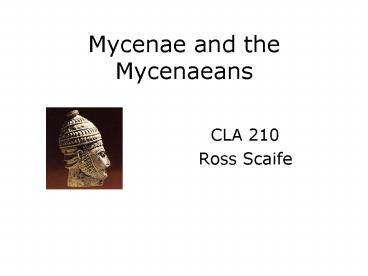Mycenae and the Mycenaeans - PowerPoint PPT Presentation
1 / 40
Title:
Mycenae and the Mycenaeans
Description:
Mycenae and the Mycenaeans. CLA 210. Ross Scaife. The Peloponnese ... and lintel, with ... Post and lintel (Lion Gate, for instance) Corbelled arch ... – PowerPoint PPT presentation
Number of Views:99
Avg rating:3.0/5.0
Title: Mycenae and the Mycenaeans
1
Mycenae and the Mycenaeans
- CLA 210
- Ross Scaife
2
The Peloponnese and southern Attica
3
The Argolid in the Peloponnese
4
Chronological Overview
- Late Helladic period c. 1550 1100 BCE
- Massive fortifications built at Mycenae, Tiryns,
Athens, and elsewhere in the 14th through 12th
centuries (cyclopean walls) - Major destructions during LH III (about 1200),
followed by economic collapse and massive
depopulation. Sic transit gloria mundi! Cause?
5
Aerial view of Mycenae
6
Mythologies associated with Mycenae
- House of Atreus key figures include Agamemnon,
Clytemnestra, Orestes - Also Menelaus and Helen of Sparta Nestor of
Pylos - Trojan War King Priam, Queen Hecuba, sons Hector
and Paris (Alexander), daughter Cassandra
7
Clytemnestra, in the Agamemnon
Here I stand and here I struck and here my work
is done. I did it all So he goes down, and the
life is bursting out of him great sprays of
blood, and the murderous shower wounds me, dyes
me black, and I, I revel like the Earth when the
spring rains come down, the blessed gifts of
god, and the new green spear splits the sheath
and rips to birth in glory! the first tragedy
in the Oresteia trilogy by Aeschylus, produced at
the theater of Dionysos in Athens c. 457 BCE
8
Orestes (son of Agamemnon) kills Aegisthus (lover
of Clytemnestra) (Attic red figure vase, early
5th century)
9
Mycenae
Lion Gate Grave Circle A Royal Megaron
10
Heinrich and Sophia Schliemann
11
Heinrich and Sophia Schliemann
- Archaeologists who worked at Troy, Mycenae, and
Tiryns - Heinrich was born in Germany 1822, died in Naples
1890 - Married (Greek) Sophie in 1869, and she worked
with him - Heinrichs early business success let them begin
excavating at Troy in 1873, then Mycenae in 1876,
where he found a double ring of slabs and,
within that ring, five shaft graves (a sixth was
found immediately after his departure). Buried
with 16 bodies in this circle of shaft graves was
a large treasure of gold, silver, bronze, and
ivory objects. Schliemann had hoped to find--and
believed he had found--the tombs of Agamemnon and
Clytemnestra. - Schliemann became a symbol not only of the new
archaeological scholarship of the second half of
the 19th century but also of the romance and
excitement of archaeology. (EB) - But in fact their legacy is quite mixed.
12
Lion Gate at Mycenae
Post and lintel, with relieving triangle
13
In general, Mycenaean gateways are so designed
that an attacker would have to present the side
on which he would normally carry his offensive
weapons (the right side, unshielded if he wanted
to wield these weapons effectively) toward the
defenders in approaching the gate. -- Rutter
14
Postern gate at Mycenae
15
Grave Circle A (reconstruction)
16
Some of the finds from Grave Circle A
- (materials usually dated c. 1600-1500 BCE)
- Death Masks
- Many other decorative gold objects
- Daggers
- (compare the later inlaid silver cup, LH III, c.
1300)
17
Two of the six gold death masks
I have just gazed upon the face of
Agamemnon!(something Schliemann probably did
not say!)
18
from Grave Circle A
(materials usually dated c. 1600-1500 BCE)
19
from Grave Circle A
20
from Grave Circle A
21
from Grave Circle A
22
Grave Circle A at Mycenae two of the many
daggers
Lion Hunt
Nilotic Scene
23
Inlaid silver cup, Mycenae (LH III , c. 1300)
24
Gold signet ringswith Mycenaean themes
25
Vaphio Cup (peaceful)
26
Vaphio Cup (peaceful)
27
Vaphio Cup (violent)
28
Vaphio Cups (comparison)
29
Some Mycenaean Architecture
- Gates and passages
- Post and lintel (Lion Gate, for instance)
- Corbelled arch
- Megaron
- Tholos tomb
30
Features of the Mycenaean Megaron
- Tripartite division into porch, vestibule, and
throne room. - Large circular hearth, centrally located in the
throne room. - Four columns arranged in a square around the
hearth in the throne room. - Two columns between antae in the porch.
31
Features of the Mycenaean Megaron
- A throne against the middle of the right-hand
wall in the throne room (only Pylos and Tiryns
for certain, but probably also Mycenae). - Plastered floors decorated with painted patterns
in the throne room, the vestibule, and the porch
(Pylos, Mycenae, and Tiryns). - Access to the throne room only from the
vestibule, through an axially placed doorway. - Rich decoration of the walls throughout the unit
by means of frescoes.
32
The procession is the most frequently repeated
theme of Mycenaean painting and is known for all
the main palaces. Stately figures are shown
carrying offerings
33
(No Transcript)
34
Treasury of Atreus (LH III)
35
Treasury of Atreus (LH III)
36
Treasury of Atreus
37
Very late Mycenaean art
- Warrior Vase from Mycenae (LH III 1200)
- Funerary Larnax from Tanagra (in Boeotia, LH III
after 1300)
38
Warrior Vase from Mycenae (LH III 1200)
39
A Funerary Larnax from Tanagra
(Larnax sarcophagus, coffin)
40
Another larnax from Tanagra































